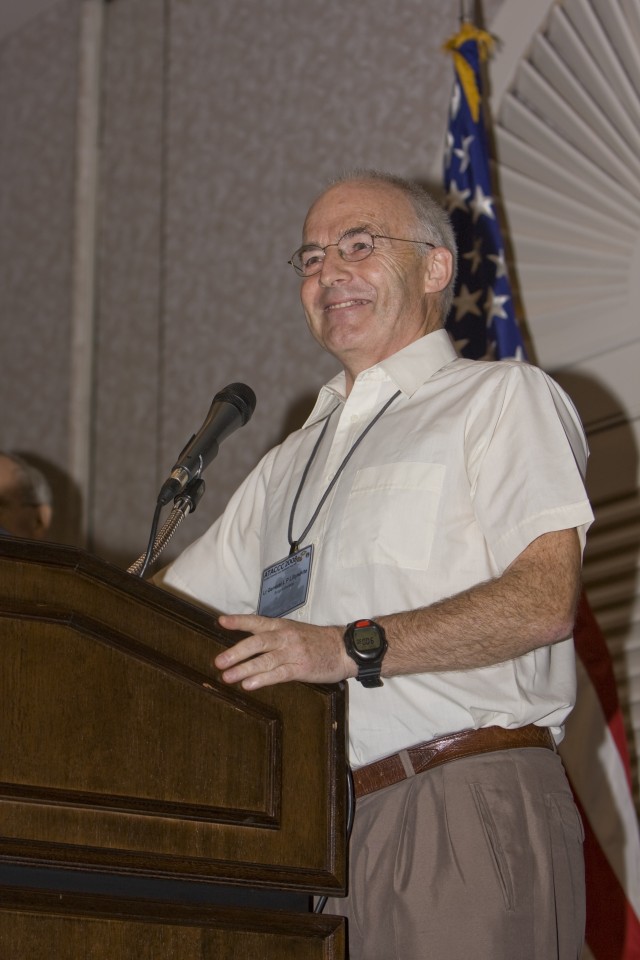Scientists and battlefield medical clinicians shared their unique knowledge and experiences to advance medicine during the military's premier trauma care conference.
The U.S. Army Medical Research and Materiel Command's annual Advanced Technology Applications for Combat Casualty Care Conference was held in St. Pete's Beach, Fla. Aug. 11 to 15.
What evolved from a disjointed vendor-oriented conference over 10 years ago with just a couple hundred participants is now an extremely relevant knowledge exchange that has the ability to improve military medicine, according to Col. Bob Vandre, former MRMC Combat Casualty Care Program director who organized the conference for more than 1,100 attendees.
"This is the meeting that talks about cutting-edge, military trauma medicine," said Vandre. "Attendees can get the latest ideas and medical inventions here - things that change the future. Most of the key palyers in field come here."
The conference is vital to the improvement of the military's Combat Casualty Care Program and has contributed to "communities of dialog" between what the clinicians in the field learned and where the researchers need to focus their efforts, said MRMC Deputy Commander Col. Jonathan Jaffin as he welcomed the conference participants.
Bringing together the key people who have the influence to change the direction of military medicine has helped bring improvements like better trained medics and better equipment, among other advancements.
"Operators come in and say 'here's the problem,'" explained Vandre. "It's a way to bring the battlefield to the scientists."
Of the more than 1,000 attendees many were from the Navy and Air Force, whose services also helped pay for the conference, along with international military trauma experts.
After being asked to attend the event five years ago, the United Kingdom's Army Surgeon General Lt. Gen. Louis Lillywhite said he now comes every year.
"This is increasingly becoming the forum for new clinical systems and performance," he said.
It was at the ATACCC conference that Lillywhite said he first saw evidence of novel hemostatic bandages, which have chitosen to stop bleeding. He added that the conference affords the opportunity to see the medical products first hand, which allows him to make a more informed decision about whether they should be fielded in his country.
With the information exchange, he can also find out where the United States military medicine efforts are and adjust his organization's accordingly.
"It facilitates focusing our research into areas where the U.S. isn't doing research," Lillywhite said. "Coming here helps us decide where to get greater money for our own research."
Although sharing a British accent with Lillywhite, Dr. Howard Champion has been in the States for more than 20 years and is a trauma surgeon who instructs at the Uniformed Services University of Health Sciences in Bethesda, Md.
"The single most valuable thing that comes out of the Combat Casualty Care meeting held each year is that it brings together U.S. and international expertise," said Champion who has attended for years.
He said the competence of the attendees at the conference is excellent and thinks a big issue for the military medicine is training.
"An example is addressing the plan for improved training and how the Army in particular is going to ensure competence in the future," said Champion about experienced medical professionals who transition out of the military. "As the exceptional training goes away, it's vitally important to sustain their professional abilities."
Future planning is a large part of the conference's agenda with research managers and a board of directors comprised of external trauma surgeons as well as other service representatives who guide the focus of studies.
"We're talking about 2010 now," said Vandre. "It's an executive-level reality check for our program."
While at the ATACCC Vandre handed off the CCC to the new director Col. Dallas Hack to take the reins and ride the momentum of energy of the conference. It was his first time attending, and Hack said the level of collaboration is exceptional.
"All these people are doing great things," he said. "We're building a crescendo of results of saving lives and reducing morbidity."
With a varied background of both operational medicine and strategic leadership teaching, Hack said it's exciting to be able to "actually make a difference" in future casualty care.
"CCC will continue to push the envelope of saving lives," he said.
Although the ATACCC is research-focused, Jaffin wanted to make sure all the scientists recognized the people who actually employ the lessons learned on the battlefield to save service members' lives.
"There's a dramatic decrease in mortality from previous wars because of the advancements made in trauma care," said Jaffin. "The key has been those medics, those doctors and medical teams doing what they do in horrible conditions."


Social Sharing